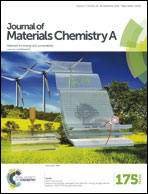Efficient, monolithic large area organohalide perovskite solar cells†
Abstract
Solar cells based on organohalide perovskites (PSCs) have made rapid progress in recent years and are a promising emerging technology. An important next evolutionary step for PSCs is their up-scaling to commercially relevant dimensions. The main challenges in scaling PSCs to be compatible with current c-Si cells are related to the limited conductivity of the transparent electrode, and the processing of a uniform and defect-free organohalide perovskite layer over large areas. In this work we present a generic and simple approach to realizing efficient solution-processed, monolithic solar cells based on methylammonium lead iodide (CH3NH3PbI3). Our devices have an aperture area of 25 cm2 without relying on an interconnected strip design, therefore reducing the complexity of the fabrication process and enhancing compatibility with the c-Si cell geometry. We utilize simple aluminum grid lines to increase the conductivity of the transparent electrode. These grid lines were exposed to an UV-ozone plasma to grow a thin aluminum oxide layer. This dramatically improves the wetting and film forming of the organohalide perovskite junction on top of the lines, reducing the probability of short circuits between the grid and the top electrode. The best devices employing these modified grids achieved power conversion efficiencies of up to 6.8%.


 Please wait while we load your content...
Please wait while we load your content...